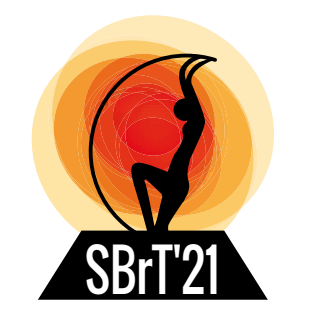
XXXIX Simpósio Brasileiro de Telecomunicações e Processamento de Sinais
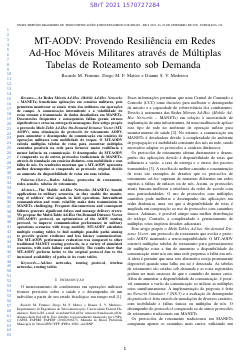
MT-AODV: Provendo Resiliência em Redes Ad-Hoc Móveis Militares através de Múltiplas Tabelas de Roteamento sob Demanda
Ricardo M Firmino, Diogo M. F. Mattos, Dianne Medeiros
DOI: 10.14209/sbrt.2021.1570727284
Keywords:
Abstract
The Mobile Ad-Hoc Networks (MANETs) benefit applications in military scenarios, as they enable the monitoring of soldiers' vital signals in field operations. Intermittent communication and route volatility make data transmission in MANETs challenging. Frequent disconnections and consequent failures generate significant delays and message delivery errors. We propose the Multi-Table Ad-Hoc On-Demand Distance Vector (MT-AODV) protocol, an optimization of the AODV routing protocol, to improve communication performance in military operations scenarios with troop mobility. MT-AODV calculates multiple routing tables to find multiple possible paths aiming to provide greater resilience and less latency communication. The MT-AODV performance evaluation was compared to other traditional MANET routing protocols, in a variety of simulated scenarios, with node failure and mobility. The results show that MT-AODV perform better to the original protocol due to the increased availability of paths in its route tables.Download
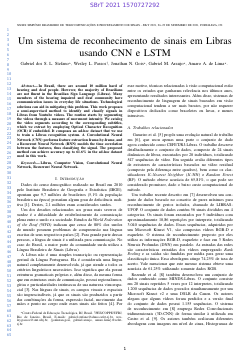
Um sistema de reconhecimento de sinais em Libras usando CNN e LSTM
Gabriel Stefano, Wesley Lobato Passos, Jonathan Gois, Gabriel Araujo, Amaro de Lima
DOI: 10.14209/sbrt.2021.1570727292
Keywords: Libras Computer Vision Convolutional Neural Network Recurrent Neural Network
Abstract
In Brazil, there are around 10 million hard of hearing and deaf people. However, the majority of Brazilians are not fluent in the Brazilian Sign Language (Libras). Many members of the hearing impaired and deaf community have communication issues in everyday life situations. Technological solutions can aid in mitigating this problem. This work proposes a semi-supervised method to identify and classify signals in Libras from Youtube videos. The routine starts by segmenting the videos through a measure of movement intensity. We catalog the video segments according to the corresponding subtitles, which we extract by employing Optical Character Recognition (OCR) if embedded. It composes an ad-hoc dataset that we use to train a Libras recognition system. A Convolutional Neural Network (CNN) performs feature extraction frame-by-frame, and a Recurrent Neural Network (RNN) models the time correlation between the features, thus classifying the signal. The proposed method can achieve accuracy up to 61.6% in the ad-hoc dataset used in this work.Download
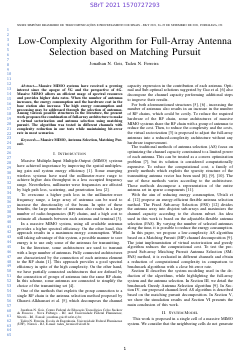
Low-Complexity Algorithm for Full-Array Antenna Selection based on Matching Pursuit
Jonathan Gois, Tadeu Ferreira
DOI: 10.14209/sbrt.2021.1570727293
Keywords: Massive MIMO Antenna Selection Matching Pursuit
Abstract
Massive MIMO systems have received a growing interest since the apogee of 5G and the perspective of 6G. Massive MIMO allows an efficient usage of spectral resources and provides higher data rates. When the number of antennas increases, the energy consumption and the hardware cost in the base station also increase. The high energy consumption and processing may be addressed through the selection of antennas. Among various possible structures in the literature, the present work proposes the combination of full-array architecture to make a virtual sectorization and antenna selection using matching pursuit. The algorithm was tested in different channels with complexity reduction in our tests while maintaining bit-error rate in most scenarios.Download

An Initial Discussion of an Adaptive Impedance Matching Circuit for PLC_ Systems
Luis Guilherme Costa, Vinícius Lagrota R. da Costa, Ândrei Camponogara, Moises Vidal Ribeiro
DOI: 10.14209/sbrt.2021.1570727298
Keywords: Power line communication coupling impedance matching analog filter
Abstract
This paper proposes an adaptive impedance matching coupling circuit for power line communication (PLC) systems operating in the frequency band of 1.7 up to 50~MHz. The proposed PLC coupling circuit is designed based on an analog filter bank approach. The simulation results show that the proposed analog filter bank approach can provide low return loss and high insertion gain in the band-pass. In general, the attained results point out that the proposed circuit constitutes an interesting research direction to improve the impedance matching between PLC transceivers and electric power grids.Download
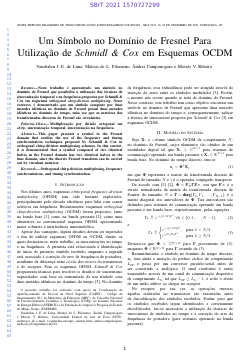
Um Símbolo no Domínio de Fresnel Para Utilização de Schmidl & Cox em Esquemas OCDM
Vanderlan Júnio Esterque de Lima, Mateus Filomeno, Ândrei Camponogara, Moises Vidal Ribeiro
DOI: 10.14209/sbrt.2021.1570727299
Keywords: Multiplexação por divisão ortogonal em chirp Sincronização temporal Sincronização na frequência
Abstract
Neste trabalho é apresentado um símbolo no domínio de Fresnel que possibilita a utilização das técnicas de sincronização temporal e na frequência propostas por Schmidl & Cox em esquemas orthogonal chirp-division multiplexing. Nesse contexto, é demonstrado que um símbolo composto por duas metades idênticas no domínio de Fresnel possui duas metades idênticas no domínio do tempo, uma vez que as matrizes das transformadas discretas de Fresnel são circulantes.Download
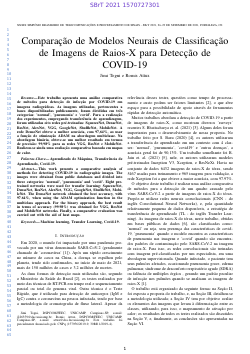
Comparação de Modelos Neurais de Classificação de Imagens de Raios-X para Detecção de COVID-19
Jimi Togni, Romis Ribeiro Attux
DOI: 10.14209/sbrt.2021.1570727301
Keywords: Aprendizado de Máquina Deep Learning COVID-19 Transferência de Aprendizado
Abstract
This work presents a comparative analysis of methods for detecting COVID-19 infection in radiographic images. The images used, belonging to publicly available databases, were divided into three categories: 'normal', 'pneumonia' and 'covid'. For carrying out the experiments, based on the technique known as transfer of learning, eight pre-trained networks were used, all commonly used for image classification and recognition: SqueezeNet, DenseNet, ResNet, AlexNet, VGG, GoogleNet, ShuffleNet, MobileNet. We opted to use these networks because they are widely used methodologies and cited in recent academic works on computer vision, detection and classification of images. As a result, it was observed that the DenseNet network obtained the best accuracy, with 97.64%, when using the ADAM optimization function in the multiclass approach. The binary approach, in turn, obtained the best result in terms of accuracy: 99.98% on the VGG, AlexNet and MobileNet networks. Finally, a comparative assessment is carried out, supported by the inspection of heat maps.Download
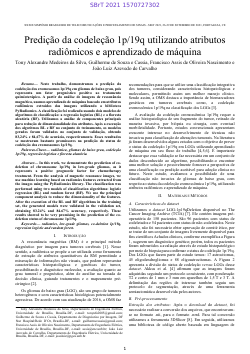
Predição da codeleção 1p/19q utilizando atributos radiômicos e aprendizado de máquina
Tony Alexandre Medeiros, Guilherme de Souza e Cassia, Francisco Assis de Oliveira Nascimento, João Luiz Azevedo de Carvalho
DOI: 10.14209/sbrt.2021.1570727302
Keywords: radiômica gliomas de baixo grau codeleção cromossômica 1p/19q aprendizado de máquina
Abstract
In this work, we demonstrate the prediction of co-deletion of chromosome 1p/19q in low-grade gliomas, as it represents a positive prognostic factor for chemotherapy treatment. From the analysis of magnetic resonance images, we use machine learning based on radiomics features extracted from the images using the PyRadiomics library. The classification was performed using two models of classification algorithms: logistic regression (RL) and random forest (RF). We use the principal component analysis to reduce the dimensionality of the features. After the execution of the RL and RF algorithms in the training set, the generated models were validated in the validation set, obtaining 83.24% and 84.67% accuracy, respectively. These results showed to be very promising in the prediction of the co-deletion status of chromosome 1p/19q.Download
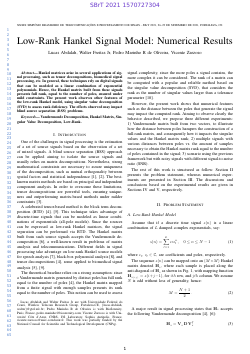
Low-Rank Hankel Signal Model: Numerical Results
Lucas Abdalah, Walter da Cruz Freitas Jr., Pedro Marinho Ramos de Oliveira, Vicente Zarzoso
DOI: 10.14209/sbrt.2021.1570727304
Keywords: Vandermonde Decomposition Hankel Matrix Singular Value Decomposition
Abstract
Hankel matrices arise in several applications of signal processing, such as tensor decompositions, biomedical signal processing, etc. In general, these techniques rely on digital signals that can be modeled as a linear combination of exponential polynomials. Hence, the Hankel matrix built from these signals presents full rank, equal to the number of poles, ensured under mild constraints. The present work observes other features of the low-rank Hankel model, using singular value decomposition (SVD) to assess rank deficiency. The effects observed may impact blind source separation (BSS) problems.Download

Solução semifechada do conformador de feixe WCO-BMVDR para aparelhos auditivos biauriculares
Wilmer Lobato, Marcio H Costa
DOI: 10.14209/sbrt.2021.1570727305
Keywords: Aparelho auditivo Conformação de feixe Otimização de desempenho do pior caso
Abstract
Resumo-Este trabalho apresenta uma solução alternativa do conformador robusto WCO-BMVDR para aparelhos auditivos biauriculares. A metodologia proposta calcula o multiplicador de Lagrange de forma iterativa, mediante o método de Newton-Raphson, para obter a solução ótima. Simulações computacionais indicam a possibilidade de aumento da qualidade da fala em até 1,1 MOS-WPESQ e da razão sinal-interferência mais ruído biauricular em até 6,2 dB. Adicionalmente, possui um tempo de processamento até 15,3 vezes menor que a forma convencional. O método proposto é especialmente efetivo para uma razão sinal-interferência de entrada entre 0 dB e 15 dB.Download
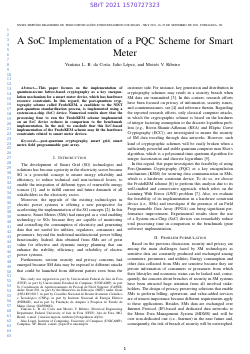
A SoC Implementation of a PQC Scheme for Smart Meter
Vinícius Lagrota R. da Costa, Julio López, Moises Vidal Ribeiro
DOI: 10.14209/sbrt.2021.1570727323
Keywords: post-quantum cryptography smart grid smart meter field programmable gate array
Abstract
This paper focuses on the implementation a quantum-secure lattice-based cryptography as a key encapsulation mechanism for a smart meter device, which has hardware resource constraint. In this regard, the post-quantum cryptography scheme called FrodoKEM, a candidate to the NIST post-quantum standardization process, is implemented using a system-on-a-chip (SoC) device. Numerical results show that the processing time to run the FrodoKEM scheme implemented in a SoC device reduces in comparison to the benchmark implementation. At the end, we conclude that this SoC-based implementation of the FrodoKEM scheme may fits the hardware constraints related to smart meter devices.Download